Future tendencies in the Overhead Line Business
 Overhead Lines OHL are an important part for the supply of electricity. Together with underground cables UGC and gas insulated lines GIL they transport energy from electric power plants to households, factories, transport facilities and are used for many other applications. The CIGRE Reference Paper “Overhead Transmission Lines, Gas Insulated Lines and Underground Cables” in ELECTRA 307, December 2019, provides an overview and presents advantages and disadvantages to the three mentioned techniques for the voltage range exceeding 170kV AC, excluding sea cables. The paper explains that “…it is very difficult to compare the three technologies as each installation is different with respect to location, importance of the circuit, costs, reputational and financial impact if there is an outage, method of installation, operational and maintenance aspects, environmental impact, planning/licensing, lifetime, etc. In view of this no general conclusions can be drawn and each installation must be treated on a case by case basis”.
Overhead Lines OHL are an important part for the supply of electricity. Together with underground cables UGC and gas insulated lines GIL they transport energy from electric power plants to households, factories, transport facilities and are used for many other applications. The CIGRE Reference Paper “Overhead Transmission Lines, Gas Insulated Lines and Underground Cables” in ELECTRA 307, December 2019, provides an overview and presents advantages and disadvantages to the three mentioned techniques for the voltage range exceeding 170kV AC, excluding sea cables. The paper explains that “…it is very difficult to compare the three technologies as each installation is different with respect to location, importance of the circuit, costs, reputational and financial impact if there is an outage, method of installation, operational and maintenance aspects, environmental impact, planning/licensing, lifetime, etc. In view of this no general conclusions can be drawn and each installation must be treated on a case by case basis”.
However, transmission lines allow the exchange of electricity among regions and countries. They also transport renewable energy from wind and solar sources, which is an important aspects in the reduction of CO2 emissions and towards achieving a greener environment. Overhead Lines are the oldest and – till today – the most common used transmission method worldwide to transport electrical energy, and especially to transport bulk energy over big distances on land.
Of course, work on OHL has changed significantly from the situation in former decades as shown in Figure 1. An example is the use of drones which is increasing worldwide as this technique allows the assessment of several components of existing OHL without taking them out of service (conductors and earth wires, corrosion on structures, fittings, insulators, warning spheres and others).

Figure 1 - historic picture from conductor stringing in the 1940ies in the European Alps
It shall be mentioned that the present article concentrates on technical aspects. The equally important environmental aspects of OHL have been discussed in edition number 4 of Future Connections (2020).
The transmission line business has become more challenging, not only for new projects, but also for existing lines. Study Committee B2 of CIGRE “Overhead Lines” covers all these aspects in its work. Examples will be given below, under the especial emphasis of CIGRE´s programme “New Generation Network (NGN)”. This entity has been created to support young engineers´ involvement in CIGRE and to express their view regarding the future of our business. Two contributions from NGN are being presented in the SC B2 Group Discussion Meeting at the 2021 Centennial Session in August this year. The authors present projects in which they are involved.
Mr. Tolulope Mayomi (Ireland) explains in his NGN-presentation the “Approach for the classification of risk of overhead line towers” by the use of machine learning. Based on normative preconditions from the OHL standard, and based on aerial pictures, the system can indicate different classifications of tower locations as “Often-Frequented” or “not Often-Frequented” based on their accessibility to people and the frequency of such access. If necessary, measures can be derived from this classification, e.g. regarding aspects of earthing conditions. In addition, recently established or altered developments, roads, etc. can be identified and estimated in relation to OHL in the vicinity. The author explains that test runs and verifications of this system in rural, suburban and urban areas are very promising. It is expected that the system can be used on a large scale in very near future.
